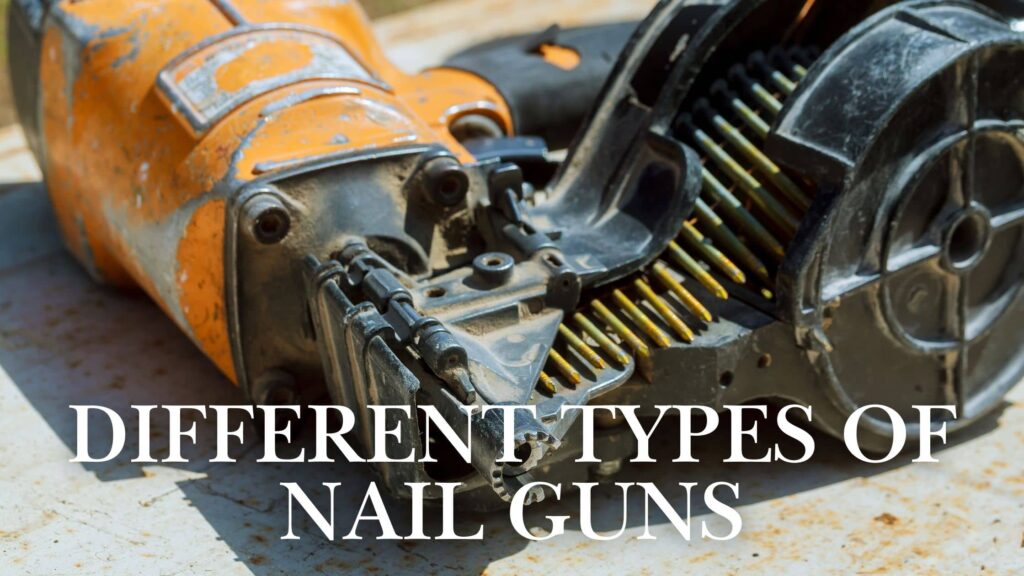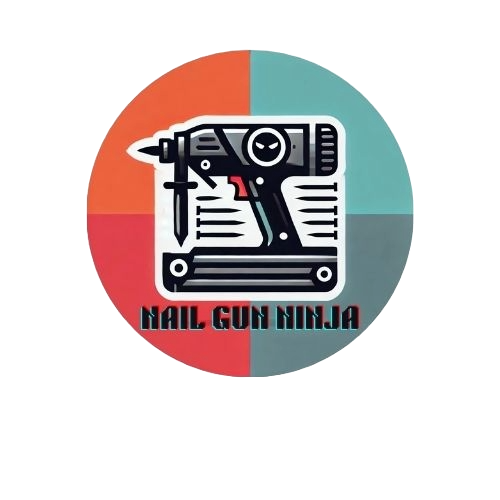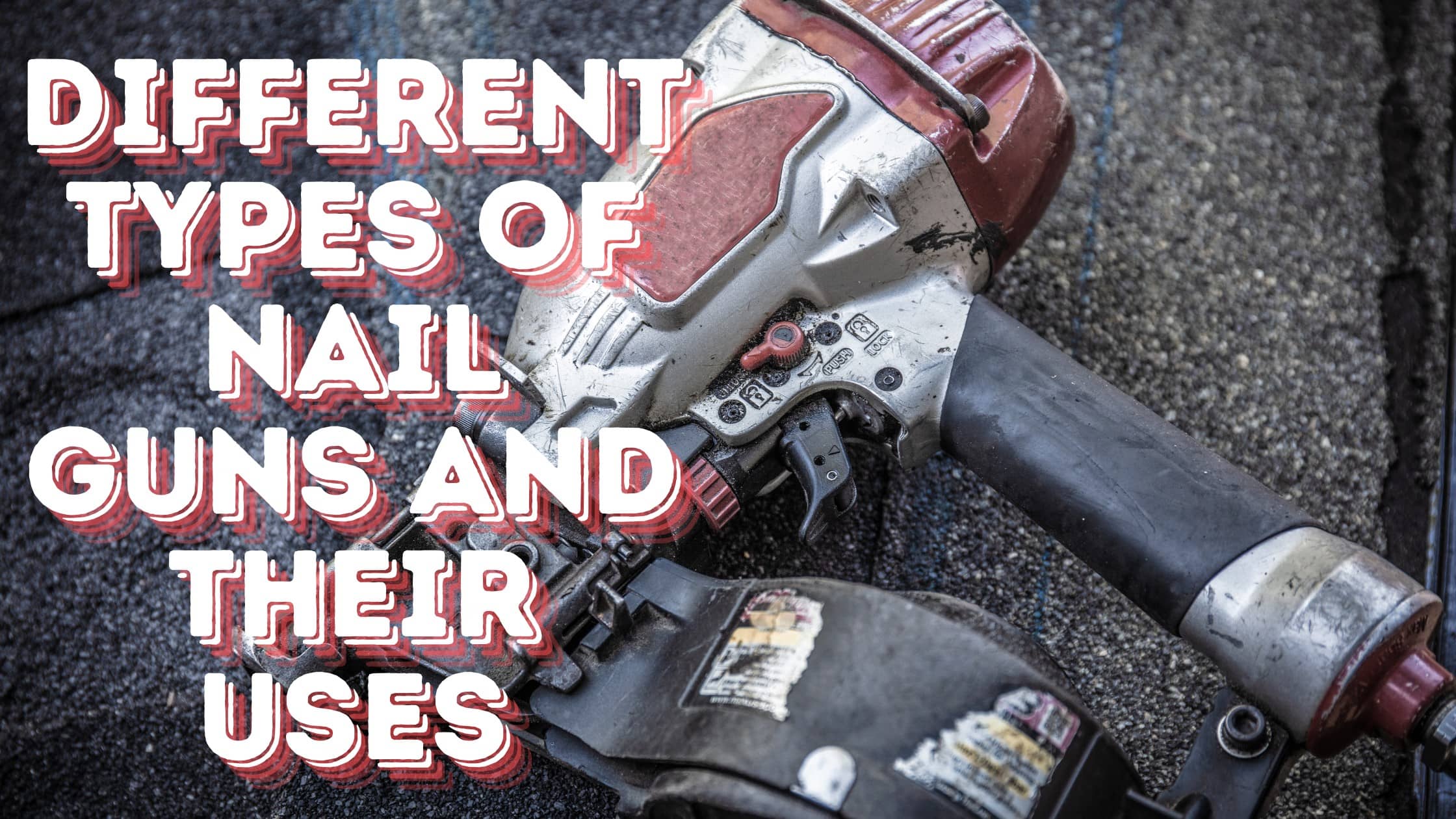From my experience, I realize that figuring out the different types of nail guns and their uses is very important. If you understand every aspect of nail guns and their best uses, you can choose the ideal tool based on your project.
Over the years, I have used various nail guns and gathered experience. Here, I will share my practical knowledge and insights on various types of nail guns. I hope this will help you choose the right nail gun for your next project.
Different Types of Nail Guns and Their Uses

Framing Nail Guns
A framing nail gun is designed to drive large nails efficiently and quickly into wooden materials. This tool is also known as a framing nailer.
It is mainly used in heavy-duty woodworking and construction projects such as building walls, floors, roofs, and decks. This tool is particularly useful where framing is involved.
Framing nail guns can handle thicker materials and join large wooden pieces securely. They carry large nails between 2 and 3.5 inches and are available in various versions, including pneumatic, cordless, and fuel-powered. There are also models of framing nail guns that work with clipped-head nails. Those are called clipped-head framing nail guns. You often need to oil your pneumatic versions for them to work smoothly.
Key Features
- High-powered operation: Provides enough force to drive large nails into tough materials like hardwood.
- Large magazine capacity: Holds 50–100 nails to ensure uninterrupted work.
- Adjustable depth control: Allows users to control nail depth based on the material.
- Variety of angles: Comes in different angles such as 21°, 28°, and 30–34°, with 21° and 30° being the most common.
- Firing modes: Features sequential and bump-firing modes, enabling users to drive nails one at a time or in rapid succession.
- Ergonomic design: Provides comfortable grips for prolonged use.
Pros and Cons
| Pros | Cons |
| Nailing speed is faster than hammers | Expensive |
| Ensures nailing consistency | Heavyweight creates hand fatigue |
| More versatility. Work with different nail sizes and wood types. | Creates loud enough that it requires hearing protection |
| Easy to use | Regular maintenance is needed |
| Offers custom depth control | Misuse can lead to injuries |
Best Uses
- Building framing projects like walls, floors, and roofs.
- Deck construction.
- Fencing projects and installing panels.
- Creating larger-scale wooden structures.
- Replacing wooden frames for renovations.
Finish Nail Guns
A finish nail gun, also known as a finish nailer, is designed for precision woodworking. This tool drives smaller nails in the range of 16- or 15-gauge.
These nail guns are designed to fasten delicate materials without splitting the wood. They can handle nails typically ranging from 1 to 2.5 inches.
Finish nails are used in trim installation, crown molding, cabinetry, and furniture assembly.
Key Features
- Thinner nails (15- or 16-gauge) to minimize wood splitting.
- Designed for precision and clean work without damaging materials.
- Features adjustable depth settings to allow users to control the depth.
- Compact and lighter design.
- Supports versatile firing modes, such as sequential or bump firing, depending on the task.
- Provides comfortable grips.
Pros and Cons
| Pros | Cons |
| Ensure a polished look since leaves minimal marks or holes | Limited Holding strength |
| Ensure a polished look since it leaves minimal marks or holes | Not ideal for heavy-duty construction works |
| Easy to use | Expensive |
| Versatile for various projects that require smaller nails | Regular maintenance for consistent performance |
| Faster and efficient | Less nail compatibility. Limited to specific gauges and nail lengths |
Best Uses
- Trim work such as installing baseboards, crown molding, and door casings.
- Cabinetry tasks like attaching cabinet frames and doors.
- Assembling lightweight furniture.
- Wainscoting projects, such as securing decorative wall panels.
- Light home or interior renovation tasks.
Brad Nail Guns
A brad nail gun is a specialized tool that drives 18-gauge nails, also known as brads. These nails are typically thin and small compared to finish nail gun nails.
Brad nails usually range from 5/8 to 2 inches in length. This size range makes the tool ideal for detailed woodworking tasks such as attaching trim, securing delicate moldings, and crafting.
The nails used in a brad nailer leave tiny marks on materials compared to finish and framing nailers. If you need a tool for aesthetic-focused finishing, this nail gun is an excellent choice.
Key Features
- Drives 18-gauge nails (5/8 to 2 inches in length).
- Causes minimal surface damage by creating small holes, ensuring seamless finishing.
- Offers depth setting customization for accurate and precise nail placement.
- Features a compact and lightweight design.
- Provides ergonomic comfort for long periods of work.
Pros and Cons
| Pros | Cons |
| Clean finish and smaller nail hole marks | Limited holding Power |
| It doesn’t split thin wood pieces | It has nail length restrictions. Inappropriate for thicker materials. |
| Easy to control and user-friendly for beginners | Not good for hardwoods. |
| Enough versatile for decorative and small-scale projects. | Struggle with harder materials because of less holding power |
| Affordable and available | Not perfect for load-bearing applications |
Best Uses
- Attaching lightweight trims and moldings.
- Installing thinner baseboards.
- Crafting or DIY projects: securing small wooden pieces.
- Securing thin panels and elements in cabinet assembly.
- Decorative tasks like fastening veneers.
Roofing Nail Guns
A roofing nail gun, or roofing nailer, is a tool specially designed to drive nails into roofing materials like roof shingles, underlayment, and tar paper. It features coil magazines, which can hold a large number of nails to reduce the need for frequent reloading during work.
Roofing nail gun nails have wide heads and short lengths, typically ranging between 3/4 and 1.75 inches. These nail guns are specifically engineered for rapid nail placement.
Roofing nail guns are ideal for roofing contractors to install and repair roofs. These nail guns are built to withstand outdoor conditions and handle heavy-duty tasks.
Key Features
- Uses nails ranging from 3/4 to 1.75 inches.
- Coil magazine with high-capacity nail storage, generally holding 120–225 nails.
- Adjustable depth control.
- Offers both sequential and contact firing modes.
- Highly durable, designed for outdoor environments.
- Maintains alignment and spacing to ensure accuracy.
- Anti-slip grips for better hand control.
Pros and Cons
| Pros | Cons |
| Efficient and faster nailing | Not versatile at all for other projects. Only for roofing |
| Uniformly driven and consistent depth | Heavier than other nailers |
| High-capacity coil magazine | Expensive |
| Durable even in harsh weather conditions | Requires regular cleaning and maintenance |
| Optimal performance since tailored for roofing applications |
Best Uses
- Installing roof shingles.
- Ideal for attaching asphalt or composite shingles.
- Replacing and repairing damaged shingles.
- Installing waterproofing layers under shingles.
- Securing lighter siding panels.
- DIY roofing tasks: Homeowners can upgrade and repair their roofs.
Pin Nail Guns
Pin nail guns, or pin nailers, are tools that drive ultra-thin 23-gauge nails, also known as pin nails (up to 1–1.5 inches). These nails are headless and leave tiny holes in materials.
If you’re working on an aesthetic and subtle project, then pin nail guns or pin nails are the best choice. This tool is crucial for securing delicate trims, lightweight moldings, and veneers without damaging or splitting the wood.
Pin nail gun pins are headless and have limited holding power, making them best suited for projects where glue or adhesives are the primary option. The pins serve as temporary clamps while the glue dries.
Key Features
- Uses 23-gauge ultra-thin nails.
- No risk of sudden splitting.
- Compact size.
- Ideal for highly detailed projects.
- Creates quieter operation than larger nails.
Pros and Cons
| Pros | Cons |
| Almost no visible holes or nail marks | No strong holding power |
| Prevents sudden damage or wood splitting | Shorter nail restrictions |
| Easy to use and Lightweight | Not ideal for general nailing jobs |
| Versatile for small craft projects | Often depends on glue or adhesives |
| Cost-effective and affordable |
Best Uses
- Trim work
- Lightweight furniture detailing
- Securing small decorative elements
- Holding veneers and panels temporarily while the glue dries
- Wood crafting projects
- Fixing small and lightweight components
Flooring Nail Guns
A flooring nail gun, or flooring nailer, is a power tool used for installing hardwood or other types of flooring. It can drive nails or staples at precise angles.
Flooring nailers are designed for tongue-and-groove flooring systems. They typically drive either cleat nails or staples, depending on the tool and the flooring material.
There are two types of flooring cleats: L-shaped and T-shaped. L-shaped cleats are available in 16-gauge and 18-gauge, and their lengths range from 1.5 to 2 inches, depending on the flooring thickness.
T-shaped cleats are slightly different from L-shaped cleats, though they are almost identical. T-shaped cleats have a gauge range of 16-gauge, and their lengths range from 1.5 to 2 inches.
Flooring staples are U-shaped, and staples with a sharp tip ensure secure penetration. U-shaped staples have a gauge range between 15.5-gauge and 16-gauge, with lengths ranging from 1 to 2 inches, depending on the flooring thickness.
Key Features
- Angle-based operation: Drive nails or staples at an angle without splitting or damaging the material.
- Secure tongue-and-groove joints of flooring boards: For precise nailing without splitting or damaging the materials.
- Mallet-activated mechanism: Some models require striking with a mallet for accurate nail placement.
- Fastener compatibility: Supports cleats or staples, based on the flooring material.
- Adjustable base plates: Ensures compatibility.
- Long-handled or padded grips: For comfort and ease of use.
Pros and Cons
| Pros | Cons |
| Ensure efficient installation | Not versatile. Only for flooring installation |
| Nails and staples are driven precisely | Expensive |
| Protect the surface of flooring boards | Mallet-activated models |
| Durable | Bulkier and heavier |
| Less chance of hand fatigue |
Best Use
- Hardwood flooring installation: Securing solid hardwood boards.
- Tongue-and-Groove Boards.
- Ideal for large-scale or professional flooring projects.
- Floor renovation or upgrade.
Siding Nail Guns
Siding nail guns, or siding nailers, are used for attaching siding materials like wood, vinyl, fiber cement, or composite boards to exterior walls. This tool is designed to simplify and speed up the siding installation process.
Drive siding nails at the correct angle to securely attach the siding without damaging or breaking the material. Siding nailers handle longer nails to penetrate both the siding and the underlying sheathing or studs.
Key Features
- Compatible nail length, ranging from 1.25 to 2.5 inches, to accommodate siding needs.
- The angled magazine is for effective nailing at the proper angles on vertical surfaces.
- Lightweight design with an anti-jam mechanism
Pros and Cons
| Pros | Cons |
| Efficient nailing compared to manual nailing | Not versatile for other applications. Limited use |
| No splitting or damaging of siding materials during installation | Expensive |
| Adjustable Depth | Needs regular maintenance |
| Handle different types of siding materials. Like from fiber cement to vinyl. | Need proper practice and training. Especially for beginners. |
| Ergonomic and lightweight design |
Best Uses
- Installing siding materials like wood, vinyl, and fiber cement.
- Attaching materials to sheathing or studs.
- Large-scale construction siding projects.
- Weatherproofing works for better durability and insulation.
Palm Nail Guns
Palm nail guns, or palm nailers, are designed to work in tight or hard-to-reach spaces. A standard nail gun cannot reach those places.
This tool fits comfortably in the palm of your hand for driving nails. It can handle different nail sizes, from 1.5 to 3.5 inches.
Palm nail guns are typically used for framing, decking, and installing joist hangers. The palm-shaped design reduces hand fatigue and offers excellent accuracy, even at awkward angles or in tight spaces.
Key Features
- Wide nail compatibility, often supporting sizes from 1.5 to 3.5 inches.
- Small enough to fit in your palm.
- Magnetized nail holder.
Pros and Cons
| Pros | Cons |
| Compact and small size | Limited Portability. Require air compressors for pneumatic models. |
| Various nail sizes | Limited and slower speed |
| Lightweight | Not for large-scale nailing |
| Better accuracy | Lower magazine capacity |
| Comfortable grip |
Best Uses
- Used in tight spaces.
- Attaching joist hangers and metal connectors.
- Smaller framing tasks and repairs.
- Deck structuring.
Staple Nail Gun
A staple nail gun is commonly known as a staple gun. Staple guns drive staples into different materials, like wood, fabric, or plastic. Staple guns use U-shaped staples to secure materials. Staple length ranges from 1/4 inch to 2 inches.
Staple guns are used in upholstery, carpeting, and woodworking. Staple guns are available in electric and pneumatic variants. Most power for heavy-duty projects comes from pneumatic variants.
Key Features
- Unlike traditional nail guns, this tool uses U-shaped staples or fasteners.
- Quick and faster stapling.
- User-friendly depth adjustment.
- Anti-jam mechanism when using compatible staple sizes.
- Versatile power sources, such as electric and pneumatic variants.
Pros and Cons
| Pros | Cons |
| Versatile applications like woodworking, upholstery, insulation | Minimal holding power |
| Quick fastening | Ideal for softwoods but not for hard materials |
| Easy to handle and use | Require limited type and size of staples |
| Accurate fastening | Not Suitable for large structural projects |
| Budget-friendly |
Best Uses
- Attaching fabric to chairs and sofas
- Cushioning or securing foam
- Installing carpet in corners or tight spaces
- Securing canvas to frames, assembling wall art, or bulletin boards
- Gardening projects or netting to wooden posts
- Packaging-related jobs
- Fixing screens in window or door frames
Choosing a Nail Gun
Choosing a nail gun depends on your project. It depends on the specific needs of your project or the type of materials you are working with.
If you plan to build framing projects like walls, floors, and roofs, framing nail guns are the perfect choice. Framing nailers can also be used for heavy-duty projects like framing or fencing, as they provide enough power and durability to drive large nails into tough materials.
For lightweight trim work or delicate molding projects, brad nail guns or finish nail guns are perfect. They use comparatively thin nails. So, if you want to finish your tasks with aesthetic and subtle touches, go for these two nailers.
If you have flooring or hardwood-related projects, a flooring nail gun is the best choice. If you have to work in tight or corner spaces where other nail guns cannot reach, go for a palm nail gun without hesitation.
Also, keep in mind important factors like nail gauge, magazine capacity, nail gun versions, and other accessories that align with your next project.
So, at this stage, it is clear how to choose a nail gun for your projects. It always depends on your specific project and needs. If you think like this before working on your project, I hope it will be helpful for you.
How Many Nail Guns Should I Have?
How many nail guns you need depends on the variety and scope of your projects. If you always work on only one specific type of project, like in workshops or houses, then you can have only one type of nail gun. But you can use different brands like Dewalt, Milwaukee, Metabo HPT, etc.
If you work on various types of projects like framing, fencing, DIY, and others, then you need to have nail guns that match your projects.
Beginners or amateurs who are not so professional and just work occasionally at home do not need to maintain multiple nail guns. But if you are a pro and work regularly for different purposes, then you can maintain different nail guns depending on your work.
However, professional woodworkers and contractors require multiple nail guns to handle different applications. Professionals who do client-based jobs should have different types of nail guns, with different models and features.
Surely, your nail gun will not choose your projects; your projects will choose your nail guns.
My Final Words
In the end, I suggest you keep enough knowledge about these different nail guns. This knowledge will help you figure out the best tool for your project. It will reduce the risk of misfiring and accidents as well.
However, it is not mandatory to know everything about all types of nail guns. I also don’t know everything about all nailers.
But at least keep a broad knowledge of the tool that you are using now. It will enhance your craftsmanship and professionalism on the job.
“Choose Your Tools Wisely”

